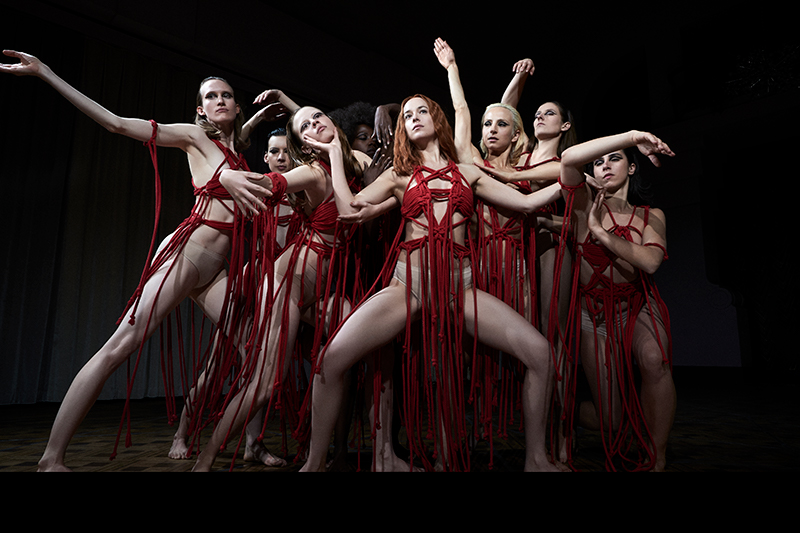Suspiria (2018)
Luca Guadagnino’s SUSPIRIA is neither remake nor reboot. Rather, it’s a re-interpretation of the source—Thomas de Quincey’s Suspiria de Profundis. In Dario Argento’s 1977 horror classic, often mischaracterized as Giallo, Nicolodi’s script rooted itself in the xenophobic superstitions of her grandmother.

Dakota Johnson in SUSPIRIA. ©2018, Amazon Studios.
We dance round in a ring and suppose,
But the Secret sits in the middle and knows.
– Robert Frost
Luca Guadagnino’s SUSPIRIA is neither remake nor reboot. Rather, it’s a re-interpretation of the source—Thomas de Quincey’s Suspiria de Profundis. In Dario Argento’s 1977 horror classic, often mischaracterized as Giallo, Nicolodi’s script rooted itself in the xenophobic superstitions of her grandmother. The witches of Argento’s film arise from arcane stereotypes of the Romani, often derided as “gypsies”.
Quincey’s Suspiria speaks of the Three Mothers—Tenebrarum (Darkness), Lachrymarum (Tears), and Suspiriorum (Sighs)—at whom Argento’s film only hints. He revisited the subject in his Three Mothers trilogy.
Through a subterranean portal (the Berlin subway), like Jessica Harper’s introduction at the Munich-Reim Airport terminal, Guadagnino’s Susie Bannion (Dakota Johnson) enters the realm of the supernatural. There, as the saying goes, the similarities end. Susie comes to the Dance Academy from a Mennonite colony in Ohio into the world of postwar Germany, a period when, her roommate recalls, “The right just wanted women to keep their mouths shut and uteruses open.” Oh, how times haven’t changed.
Guadagnino’s film works on the strength of complementary tone. Baz Luhrmann’s ROMEO + JULIET grated on me because Shakespearean prose doesn’t roll off Leonardo DiCaprio’s tongue—not that his modern English is any better. The feminist horror of Guadagnino’s SUSPIRIA, unfolds in the Deutscher Herbst of Berlin, 1977—a period of random and chaotic death. The color palette, architecture, costume design, reflect the mood of the period. Imagine attempting to, let’s say, wedge the Helena Markos Tanz Gruppe between Millennial Europop and social media references! Maybe it’s my visceral fear of corduroy speaking, but the depressing palette of the late 1970’s terrifies more than the exhausted techno-terrors of late, which play like some of the worst bits of A NIGHTMARE ON ELM STREET 5.
A key quality distinguishing both films from their contemporaries: the women of Tanz Akademie aren’t propped up as mere targets for a slasher epic. There are good and evil men and women in this world. Guadagnino, however, relies on more direct exposition—”We understand the importance of a woman’s financial autonomy”—and not necessarily as a directing choice. A sub-plot involving Tilda Swinton in a secondary role, in addition to her Madame Blanc (the head dance instructor), attempts, in a heavy-handed epilogue meant to be tender, to leave us with the benevolent side of witchcraft.
Perhaps more literal-minded than Argento, he doesn’t seem to understand American idiom as well, or use visual language to bridge the gap. Argento tangentially invoked imagery, sound, light and location to speak to Germany’s connection with the occult, e.g. the Tanz Akademie’s locale, Freiburg, where sixteenth century witchcraft trials took place on the edge of the Schwarzwald (Black Forest), or the night-time dog attack in the square of the Staatliche Antikensammlung, an architectural monument to Greco-Roman ideals, used for Nazi offices in World War II.
Guadagnino’s film is far less subtle. There are overt remnants of of the war—relocation of the film’s setting to Berlin so the Wall can figure prominently in B-roll—to more directly connect with Nazism and its fascination with the occult. The witches in Guadagnino’s film openly flaunt their influence on authority, forcing an investigator to strip naked so they can ridicule his penis.
The amateurish vulgarity gives way, however, to the picture’s more harmonious interplay between witchcraft and dance, which comes into full view during the the theatre group’s performance of a new piece, titled Volk—a reference to German nationalism and the idealized übermensch, or in this case the überfraülein. In the disconnected maze of the academy, where we can’t quite tell where one room is in relation to any other, the sole exception is the dance stage, directly underneath which is a rehearsal space possessed of a supernatural presence of which even the witches aren’t completely aware. Each body movement becomes part of a kinetic incantation that I can only describe as grotesque contortion.
We also learn that the Academy is split into different factions. The true evil in the film exploits these divisions, murdering other dancers and even some of the staff. From this revelation, the film takes a hard left turn into the deliciously insane climax. The denouement may be predictable, but it’s the how that gets you. I hesitate to say much, not because I worry about my readers coming this far without the basic understanding that all film reviews, more or less, contain spoilers. I just think the ending is so awesomely bonkers, you must see it for yourself. So this is all I’ll say: Set to the lilting vocals and haunting strings composed and arranged by Radiohead’s Thom Yorke, Susie’s victory over the witches is, this time, a crimson orgy of a Dervish dance perhaps inspired by Brian DePalma’s Cuisinart.